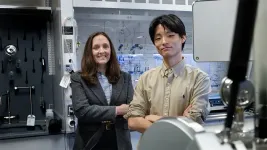(Press-News.org) The Brain & Behavior Research Foundation (BBRF) invites the public to a free webinar, “Emerging Treatments for Social Disconnection in Psychiatric Illness” on Tuesday, March 11, 2025, at 2:00 pm ET.
Register Now to explore groundbreaking research on the mental health issue: social disconnection.
Defined as social isolation and loneliness, social disconnection is a major health comparable to smoking, according to the National Institutes of Health. Social disconnection is widespread in psychiatric illness, and social dysfunction is a symptom that spans the spectrum of psychiatric diagnoses. Despite its significant impact, no pharmacologic treatments are currently available to improve social connection. However, promising new research in the field of social psychopharmacology is exploring innovative ways to address this gap.
In this webinar, Anya Bershad M.D., PhD., Assistant Professor in the Department of Psychiatry and Semel Institute for Neuroscience and Human Behavior at UCLA, will discuss her latest findings on how pharmacologic compounds could improve social connection in psychiatric illness.
The session will be hosted by Jeffrey Borenstein, M.D., President & CEO of the Brain & Behavior Research Foundation and host of the Emmy® nominated television series Healthy Minds.
About Brain & Behavior Research Foundation
The Brain & Behavior Research Foundation (BBRF) awards research grants to develop improved treatments, cures, and methods of prevention for mental illness. These illnesses include addiction, ADHD, anxiety, autism, bipolar disorder, borderline personality disorder, depression, eating disorders, OCD, PTSD, and schizophrenia, as well as research on suicide prevention. Since 1987, the Foundation has awarded more than $462 million to fund more than 5,600 leading scientists around the world. 100% of every dollar donated for research is invested in research. BBRF operating expenses are covered by separate foundation grants. BBRF is the producer of the Emmy® nominated public television series Healthy Minds with Dr. Jeffrey Borenstein, which aims to remove the stigma of mental illness and demonstrate that with help, there is hope.
END
Emerging treatments for social disconnection in psychiatric illness
A free webinar from the Brain & Behavior Research Foundation
2025-02-27
ELSE PRESS RELEASES FROM THIS DATE:
Leading the charge to better batteries
2025-02-27
From laptops to electric vehicles, lithium-ion batteries power everyday life. However, as demand for longer-lasting devices threatens to outstrip the energy that lithium-ion supplies, researchers are on the hunt for more powerful batteries.
A team led by Kelsey Hatzell, an associate professor of mechanical and aerospace engineering and the Andlinger Center for Energy and the Environment, has uncovered insights that could help power a new type of battery, called an anode-free solid-state battery, past lithium-ion’s limitations.
By understanding how ...
Consequences of overplanting rootworm-resistant maize in the US Corn Belt
2025-02-27
Widespread use of genetically engineered Bt maize, designed to combat rootworm pests, has led to overplanting and pest resistance, jeopardizing the crop’s long-term effectiveness, according to a new study. The findings – informed by data from ten U.S. “Corn Belt” states – estimate that this overuse has cost U.S. farmers $1.6 billion in economic losses, emphasizing the need for improved seed diversity, transparency, and farmer decision-making to sustain transgenic crop benefits. “If current and future related innovations are managed as Bt maize hybrids have been,” say the authors, “we risk entering ...
The distinct role of Earth’s orbit in 100-thousand-year glacial cycles
2025-02-27
The ebb and flow of Pleistocene glacial cycles is not random; it follows a predictable pattern dictated by the distinct and deterministic influence of Earth’s orbital geometry, according to a new study. The findings highlight the roles of precession, obliquity, and eccentricity – factors influencing the tilt and movement of Earth's axis, and the shape of Earth's orbit around the Sun – in glacial transitions. They also establish a predictive model for past and future glacial cycles based ...
Genome-based phylogeny resolves complicated Molluscan family tree
2025-02-27
From octopuses to snails, the complicated molluscan family tree has now been mapped in unprecedented detail, researchers report. This includes sequences for 13 new complete genomes from across the phylum. The genome-based phylogeny helps to resolve long-standing evolutionary debates and provides new insights into how the extraordinary diversity of species emerged from a single common ancestor. The phylum Mollusca is highly diverse with myriad morphological, ecological, and behavioral adaptions spanning both terrestrial and aquatic environments. The most well-known groups – bivalves, ...
Studying locusts in virtual reality challenges models of collective behavior
2025-02-27
A study of locusts navigating in a novel virtual reality (VR) environment challenges traditional models of collective swarming behavior, researchers report. The findings show that the insects don’t just follow their neighbors like self-propelled particles but instead rely on internal cognitive decision-making processes to navigate as a collective. Collective motion, a phenomenon found widely in nature, has traditionally been described using "self-propelled particle" theoretical models from physics. These “classical” models of collective behavior, like ...
ACC, AHA issue new acute coronary syndromes guideline
2025-02-27
The American College of Cardiology and the American Heart Association today released an updated clinical practice guideline for managing individuals experiencing acute coronary syndrome (ACS). The guideline incorporates new evidence and updated recommendations to improve quality of care and outcomes. The 2025 ACC/AHA/ACEP/NAEMSP/SCAI Guideline for the Management of Patients With Acute Coronary Syndromes is published simultaneously today in JACC, the flagship journal of the American College of Cardiology, and in the American Heart Association’s flagship journal Circulation.
ACS includes a ...
Scientists match Earth’s ice age cycles with orbital shifts
2025-02-27
(Santa Barbara, Calif.) — Beginning around 2.5 million years ago, Earth entered an era marked by successive ice ages and interglacial periods, emerging from the last glaciation around 11,700 years ago. A new analysis suggests the onset of the next ice age could be expected in 10,000 years’ time.
An international team, including researchers form UC Santa Barbara, made their prediction based on a new interpretation of the small changes in Earth’s orbit of the sun, which lead to massive shifts in the planet’s climate over periods of thousands of years. The study tracks the natural cycles of the planet’s climate over a period ...
Quantum interference in molecule-surface collisions
2025-02-27
The quantum rules shaping molecular collisions are now coming into focus, offering fresh insights for chemistry and materials science.
When molecules collide with surfaces, a complex exchange of energy takes place between the molecule and the atoms composing the surface. But beneath this dizzying complexity, quantum mechanics, which celebrates its 100th anniversary this year, governs the process.
Quantum interference, in particular, plays a key role. It occurs when different pathways that a molecule can take overlap, resulting ...
Discovery of a common ‘weapon’ used by disease-causing fungi could help engineer more resilient food crops
2025-02-27
The discovery of a powerful “weapon” used by many disease-causing fungi to infect and destroy major food crop staples, such as rice and corn, could offer new strategies to bolster global food security, according to researchers from The Australian National University (ANU) in collaboration with scientists in Germany and the United States.
Like humans, many fungi rely on plants as a food source. This impacts the yield of food crops. It’s estimated farmers lose between 10 to 23 per cent of their crops to fungal disease every year.
The global research team discovered that an enzyme known as a ‘NUDIX hydrolase’ is ...
University of Oklahoma researcher to create new coding language, computing infrastructure
2025-02-27
NORMAN, OKLA. – In an increasingly data-saturated world, computing infrastructure innovations are needed to make sense of new types of information. Richard Veras, a professor in the School of Computer Science at the University of Oklahoma, has received a National Science Foundation Faculty Early Career Development Program (CAREER) award to develop such an innovation by creating more efficient infrastructure for the computation of sparse and irregular data.
Big data – datasets that are challenging to manage using traditional processing tools due to size and complexity, such as social ...
LAST 30 PRESS RELEASES:
New study shows how the spleen helps the immune system accept a transplant
New Mayo Clinic study advances personalized prostate cancer education with an EHR-integrated AI agent
Researchers identify novel therapeutic target to improve recovery after nerve injury
Microbes in breast milk help populate infant gut microbiomes
Reprogramming immunity to rewrite the story of Type 1 diabetes
New tool narrows the search for ideal material structures
Artificial saliva containing sugarcane protein helps protect the teeth of patients with head and neck cancer
Understanding the role of linear ubiquitination in T-tubule biogenesis
Researchers identify urban atmosphere as primary reservoir of microplastics
World’s oldest arrow poison – 60,000-year-old traces reveal early advanced hunting techniques
Bristol scientists discover early sponges were soft
New study uncovers how rice viruses manipulate plant defenses to protect insect vectors
NSF–DOE Vera C. Rubin Observatory spots record-breaking asteroid in pre-survey observations
Ribosomal engineering creates “super-probiotic” bacteria
This self-powered eye tracker harnesses energy from blinking and is as comfortable as everyday glasses
Adverse prenatal exposures linked to higher rates of mental health issues, brain changes in adolescents
Restoring mitochondria shows promise for treating chronic nerve pain
Nature study identifies a molecular switch that controls transitions between single-celled and multicellular forms
USU chemists' CRISPR discovery could lead to single diagnostic test for COVID, flu, RSV
Early hominins from Morocco reveal an African lineage near the root of Homo sapiens
Small chimps, big risks: What chimps show us about our own behavior
We finally know how the most common types of planets are created
Thirty-year risk of cardiovascular disease among healthy women according to clinical thresholds of lipoprotein(a)
Yoga for opioid withdrawal and autonomic regulation
Gene therapy ‘switch’ may offer non-addictive pain relief
Study shows your genes determine how fast your DNA mutates with age
Common brain parasite can infect your immune cells. Here's why that's probably OK
International experts connect infections and aging through cellular senescence
An AI–DFT integrated framework accelerates materials discovery and design
Twist to reshape, shift to transform: Bilayer structure enables multifunctional imaging
[Press-News.org] Emerging treatments for social disconnection in psychiatric illnessA free webinar from the Brain & Behavior Research Foundation





